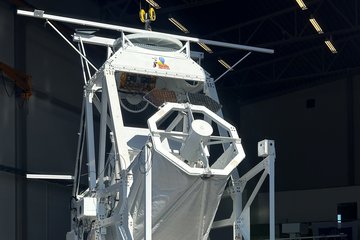All genres
1.
Journal Article
Estimation of Spectral Solar Irradiance in the Ecliptic Plane Using Synthetic Solar Surface Magnetograms. Journal of Geophysical Research (Space Physics) 129, p. e2024JA032601 (2024)
2.
Journal Article
Low-latitude Magnetic Flux Emergence on Rapidly Rotating Solar-type Stars. The Astrophysical Journal 976, p. 215 (2024)
3.
Journal Article
Reliable Transmission Spectrum Extraction with a Three-parameter Limb-darkening Law. The Astrophysical Journal 977, p. L7 (2024)
4.
Journal Article
Correlations between Total and Spectral Solar Irradiance Variations. The Astrophysical Journal 964, p. 60 (2024)
5.
Journal Article
Correlations between Total and Spectral Solar Irradiance Variations. The Astrophysical Journal 964, p. 60 (2024)
6.
Journal Article
Magnetic origin of the discrepancy between stellar limb-darkening models and observations. Nature Astronomy (2024)
7.
Journal Article
Magnetic origin of the discrepancy between stellar limb-darkening models and observations. Nature Astronomy 8, pp. 929 - 937 (2024)
8.
Journal Article
Why Observations at Mid-infrared Wavelengths Partially Mitigate M Dwarf Star Host Stellar Activity Contamination in Exoplanet Transmission Spectroscopy. The Astrophysical Journal 970, p. 155 (2024)
9.
Journal Article
Transition of the Sun to a Regime of High Activity: Implications for the Earth Climate and Role of Atmospheric Chemistry. JOURNAL OF GEOPHYSICAL RESEARCH-ATMOSPHERES (15) (2024)
10.
Journal Article
Sun-like stars produce superflares roughly once per century. Science 386, pp. 1301 - 1305 (2024)
11.
Journal Article
Testing MURaM and MPS-ATLAS against the quiet solar spectrum. Astronomy and Astrophysics 681, p. A81 (2024)
12.
Journal Article
Forward modelling of brightness variations in Sun-like stars. II. Light curves and variability. Astronomy and Astrophysics 672, A138 (2023)
13.
Journal Article
Climate implications of the sun transition to higher activity mode. Journal of Atmospheric and Solar-Terrestrial Physics 244, p. 106020 (2023)
14.
Journal Article
Spectral variability of photospheric radiation due to faculae - II. Facular contrasts for cool main-sequence stars. Monthly Notices of the Royal Astronomical Society 524, pp. 1139 - 1155 (2023)
15.
Journal Article
New rotation period measurements of 67 163 Kepler stars. Astronomy and Astrophysics 678, p. A24 (2023)
16.
Journal Article
Modeling Stellar Ca II H and K Emission Variations: Spot Contribution to the S-index. The Astrophysical Journal 956, p. L10 (2023)
17.
Journal Article
Small-scale dynamo in cool stars. II. The effect of metallicity. Astronomy and Astrophysics 669, p. A157 (2023)
18.
Journal Article
Small-scale dynamo in cool stars. I. Changes in stratification and near-surface convection for main-sequence spectral types. Astronomy and Astrophysics 663, p. A166 (2022)
19.
Journal Article
Multiwavelength Mitigation of Stellar Activity in Astrometric Planet Detection. The Astronomical Journal 163, p. 205 (2022)
20.
Journal Article
Multiwavelength Mitigation of Stellar Activity in Astrometric Planet Detection. The Astronomical Journal 163, p. 205 (2022)











